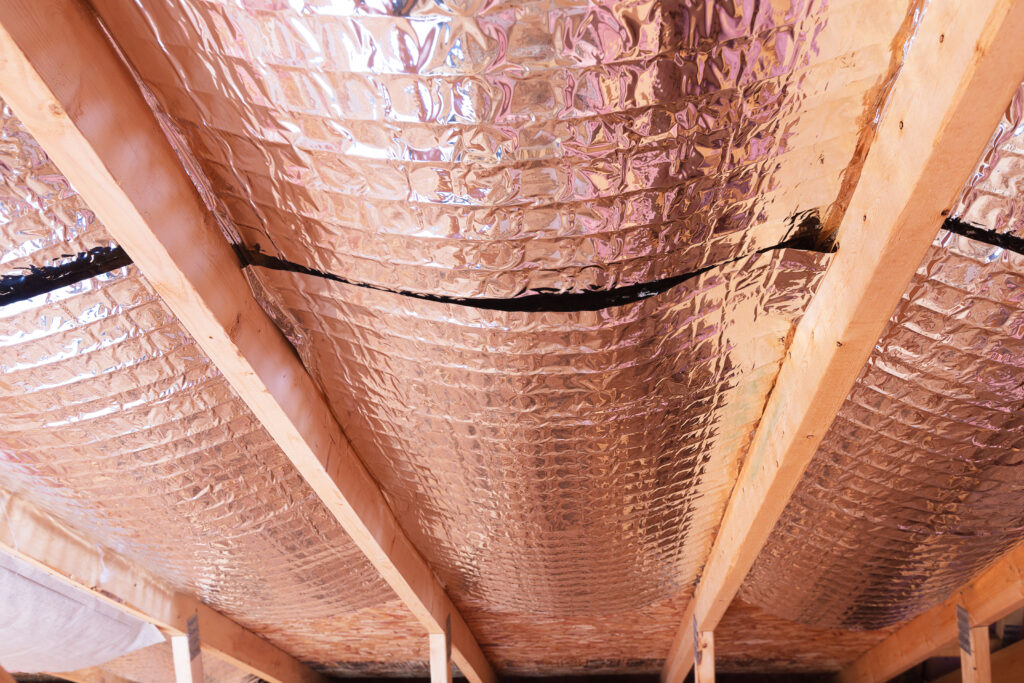Buyers Guide to Radiant Barrier Materials
Are you tired of feeling like you’re constantly throwing money out the window when it comes to keeping your home cool in the summer and warm in the winter? If so, you should check out your options in radiant barrier material.
This energy-saving product is a game changer for homeowners looking to maximize efficiency and savings. Radiant barrier material works by reflecting heat away from your home, thereby reducing the need for excess air conditioning or heating.
It’s a simple yet effective solution that can make a big difference in your home’s comfort and your wallet. Plus, with easy installation, you won’t have to worry about a major construction project. Most professional radiant barrier installers will be in and out in a day, so you can start enjoying the benefits right away.
What is a Radiant Barrier and How Does it Work?
A radiant barrier is a type of material designed to reduce the amount of heat transfer through radiation. It is usually made of materials that reflect radiant heat, such as aluminum foil or metalized plastic films.
Radiant energy travels in a straight line and heats up anything it hits. This includes the roof, walls, and floors of a building. Radiant barriers work by reflecting that heat away from the surface before it can be absorbed, keeping the interior cooler. It is especially useful in warmer climates where air conditioning costs can be high.
You can install radiant barriers in a variety of locations, including attic spaces, walls, and floors. It is often installed on the underside of the roof in the attic, where it can block heat from entering the living space of the home. The effectiveness of a radiant barrier will depend on the quality of the installation, the location of the installation, and other factors such as the orientation and slope of the roof.
Department of Energy Guidelines for Radiant Barrier
The Department of Energy (DOE) offers guidelines for the use of radiant barriers to help homeowners improve their energy efficiency and reduce their energy costs. These guidelines outline the following recommendations:
- Radiant barriers work best in hot climates where cooling costs are a concern. They are not as effective in cooler climates.
- Radiant barriers should be installed in attics, between the roof and the insulation, and should be installed perpendicular to the attic floor.
- The material should have a reflectance value of at least 0.1 and an emissivity value of 0.05 or less.
- All radiant barriers should be installed with an air gap between them and the insulation to ensure the best results.
- When installing radiant barriers, it is important to use proper safety equipment, such as gloves, goggles, and a mask, to avoid inhalation of fiberglass particles.
- Radiant barriers should not be used as a substitute for insulation. Proper insulation is still necessary to ensure energy efficiency.
- Homeowners should consult with a professional to determine if the installation of a radiant barrier is appropriate for their home and to ensure that it is installed correctly.
By following these guidelines, homeowners can effectively use radiant barriers to improve their energy efficiency and save on their energy costs.
Solar Energy and Radiant Barriers
Solar energy refers to the energy that is generated from the radiation of the sun. It is a renewable source of energy that can be harnessed in various ways, including through the use of solar panels. Solar energy is considered an environmentally friendly alternative to traditional forms of energy, such as fossil fuels because it does not emit pollutants or greenhouse gases.
However, the use of solar energy can also result in higher temperatures within buildings or homes. This is where radiant barriers come in. Radiant barriers are materials that are placed in the attic or walls of a building in order to reflect heat away from the living space.
Solar energy and radiant barriers combined can be a highly effective way to reduce energy consumption and costs in homes and buildings.
Harnessing the power of the sun while minimizing the heat transfer into the living space means homeowners can save money on energy costs.
What Types of Radiant Barrier Materials are Available?
Radiant barrier materials are available in three different variations, which include:
Reflective Foil Radiant Barriers
Reflective foil radiant barriers are materials designed to minimize heat transfer via radiation. These barriers are most commonly used in attics and walls, where the heat generated by the sun is transferred through the roof or walls into the living spaces.
Reflective foil radiant barriers work by reflecting the majority of the heat energy back toward its source, preventing it from entering the living space.
Reflective Fabric Radiant Barriers
Reflective fabric radiant barriers are made of a highly reflective material, such as aluminum, which is used to reduce the heat transfer between different areas of a structure. These barriers can be installed in a variety of locations, including the attic, roof, walls, and floors.
When installed in the attic, the reflective fabric radiant barrier prevents the heat from escaping through the roof during the winter months. During the summer, it blocks the sun’s rays from entering the home, helping to keep the interior cooler. In walls, the radiant barrier reduces the heat transfer, keeping the interior temperature moderate and comfortable.
Reflective fabric radiant barriers are lightweight, flexible, and easy to install with proper training. They don’t take up much space, don’t produce any harmful gases, and are a cost-effective and efficient solution to reducing energy consumption. They are particularly useful for homes in very hot climates.
Aluminum Foil Radiant Barriers
Aluminum foil radiant barriers are insulation materials designed to limit the flow of radiant heat between two surfaces. These barriers consist of a layer of aluminum foil attached to a substrate material, such as kraft paper or cardboard, to provide strength and support.
These barriers work by reflecting the radiant heat that is emitted by hot surfaces, such as the roof of a building on a sunny day. The aluminum foil reflects up to 97% of the radiant heat, reducing the amount of heat that enters the building. This helps to keep the building cooler and reduces the need for air conditioning, which can result in lower energy bills.
Aluminum foil radiant barriers are often used in attics, where they are installed under the roof to reflect heat and prevent it from being absorbed by the insulation or entering the living spaces below. They can also be installed on walls, floors, and in crawl spaces to reduce heat transfer.
Overall, aluminum foil radiant barriers are an effective and affordable way to improve the energy efficiency of homes and buildings and can help reduce energy costs and increase comfort levels.
What To Consider When Purchasing a Radiant Barrier Product?
With so many options on the market, how do you decide which radiant barrier material is best for you? Here’s a list of factors to consider when choosing the perfect radiant barrier product for your needs.
Reflectivity
The whole point of a radiant barrier is to reflect heat, right? So, it’s super important to pick a product with high reflectivity. Look for materials with a reflectivity rate of at least 90% to ensure maximum heat reflection and energy savings. Remember, the shinier, the better!
Thickness and Durability
You want your radiant barrier to last a long time? That’s why it’s essential to choose a material that’s both thick and durable. Thicker materials are more resistant to tears and punctures, ensuring your investment lasts for years to come. Don’t forget to also look for a material that’s resistant to moisture, mold, and mildew for extra protection.
Independent Testing and Certification
It’s always a good idea to look for products that have been independently tested and certified. This way, you know you’re getting a high-quality, reliable product that meets industry standards. Keep an eye out for certifications like ASTM or ENERGY STAR, which indicate a top-notch radiant barrier.
Cost and Value of the Product
Budget is always a consideration, but don’t just look at the price tag. Consider the value of the product as well. A cheaper insulation service might seem like a bargain, but if it doesn’t perform well or lasts only a short time, you might end up spending more in the long run. Look for a radiant barrier that offers a good balance between cost and performance to make sure you’re getting the best bang for your buck.
Purchasing and installing a radiant barrier is an excellent investment for homeowners looking to increase their home’s energy efficiency, reduce utility bills, and create a more comfortable living environment.
By choosing an installer of radiant barriers near you, you like Attic Pros, you can rest easy knowing your home will benefit from the expertise and experience of trained technicians. So, go ahead and make that smart investment, and let the professionals at Attic Pros help you achieve a more comfortable, energy-efficient home.

